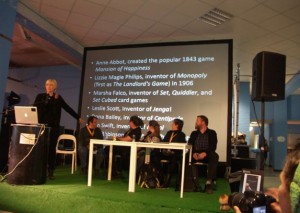The Tiltfactor team was busy at DiGRA 2011. Thursday September 15th, I presented (with Jonathan Belman) our paper on the design approach behind POX:SAVE THE PEOPLE. Friday September 16th, Jonathan Belman shared our latest paper on our Grow-A-Game cards, “Grow-A-Game: A Tool for Values Conscious Design and Analysis of Digital Games,” with audience members on Friday. Read the essays now!
Digra2011-PreventingPox-FlanaganEtAl-Paper
Digra2011 – GrowAGameTool-BelmanNissenbaumFlanaganDiamond
See below for full citations on these articles!
I was then part of a lively panel organized by Clara Fernandez on Growing a Game Lab (2.0), with many esteemed lab founders on the panel and in the audience. Clara has since formed an email list for lab directors to share information and create an international network, so contact her if you wish to join. I also had the privilege to interview Antanas Mockus Šivickas on “Politics and Serious Play.” This was an inspirational talk via skype with the awesome former mayor of Bogota, who created a playful Cultura Ciudadana in the city and transformed its efficiency, safety, and equity. I went on to do a game educator’s rant, hosted by Jose Zagal.
Finally, I gave a keynote talk, “rethink, redesign, and replay,” where I offered 12 propositions from a critical play perspective. In the talk, I looked at values in the process of designing games, and the notion that small changes in games ripple out to large effect. Games are good, after all, at modeling systems and dependencies. It is therefore important to see how they also include the human nuances in that design. I also discussed the differences and similarities between art and design, and how player engagement could be related to a strong sense of responsibility.
Aside from Tiltfactor’s direct involvement with the conference, we learned a great deal from the host of papers and presentations at the conference. Eric Zimmerman’s keynote celebrated the link between games and art, something close to the Tiltfactor ethos. He instructed game designers not to think of games as “instrumental” towards another end such as learning, and exhorted the audience to think of themselves from an art education perspective and look for the value and beauty of games in and of themselves.
A theme of interrogating gender in games also ran through the conference in a way I’ve not seen in any conference. This could be due to the high number of game scholars who are women, yet remain little known; it could be due to the way gender is researched (or not) by novice teams; or it could reflect the game industry’s rather low numbers of women compared to other fields. Regardless, several discussions, including a strong keynote by Suzanne de Castell and Jennifer Jenson, challenged researchers + thinkers at the conference to pay attention to the complex arena of gender–do the background reading, ask the questions, set up balanced studies, and actively cite female colleagues.
Saturday September 17th, 2011, Bernie DeKoven, “Defender of the Playful,” gave an inspirational keynote and led an amazing outdoor play workshop. You may be familiar with DeKoven’s games from the big colored parachutes used in classrooms– that’s his invention, with Todd Strong. In The Well Played Game, DeKoven argued for a philosophy of “healthy competition,” and in the 1970s these ideas formed the core teachings of the New Games Foundation. He became co-director of the foundation, and has developed an internationally successful program in collaborative games and events. We played Prui, the universal “sit on the lap of the person behind you” chain game, and other games that are useful to remind ourselves not only of our own embodiment, but that connecting with others through play is a process of sheer pleasure. Such play promotes feelings of solidarity and sharing. It was a profoundly moving session. There were many parallel sessions going on concurrently — one of which, a LARP organized by Jakko Stenros (creator of a new beautiful book, Nordic LARP with Markus Montola), involved a group of players figuring out the story in the middle of a collective hangover.
All in all, the most inspiring DiGRA yet. Gone is the bickering over narratology vs ludology, and in its place is a more holistic, phenomenological, embodied playspace of possibilities.
* * Citations are listed below for the two Tiltfactor DiGRA papers, so that you may use them in your research.
Flanagan, Mary, Seidman, Max, Belman, Jonathan, Punjasthitkul, Sukdith, Downs, Zara, Ayoob, Mike, Driscoll, Alicia, and Downs, Martin. “Preventing a POX Among the People? Community-based Game Design for ‘Herd Immunity.’” Proceedings of DiGRA 2011 Conference: Think Design Play. Hilversum: The Netherlands, 14-17 2011.
Belman, Jonathan, Flanagan, Mary, Nissenbaum, Helen, and Diamond, Jim. “Grow-A-Game: A Tool for Values Conscious Design and Analysis of Digital Games.” Proceedings of DiGRA 2011 Conference: Think Design Play. Hilversum: The Netherlands, 14-17 2011.


